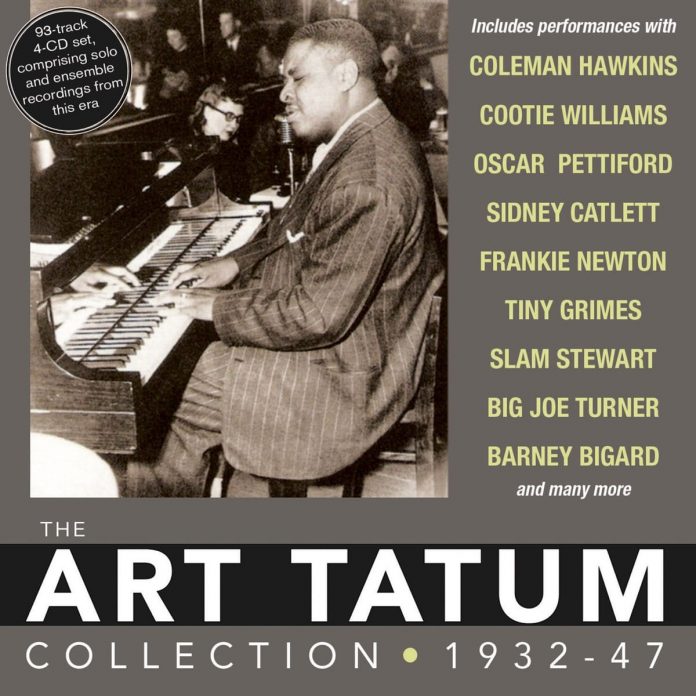This four-CD set gives a substantial and representative overview of the first 15 years of Tatum’s recording career. The 93 tracks, mainly solos, include 13 recordings by his 1944 trio with Tiny Grimes and Slam Stewart, and a few small group performances with Big Joe Turner, Ed Hall, Coleman Hawkins and Barney Bigard, all well worth hearing, besides providing examples of Tatum’s interaction with other musicians.
He was blessed with a phenomenal technique and enjoyed showcasing it with dazzling virtuosity in ornately embellished, supercharged stride style. (Fats Waller was an early friend and inspiration). Art could play with amazing speed and digital dexterity in two-handed dialogue, his percussive and accurate touch imparting a bright, ringing tone. The tempo of his famous 1940 recording of Tiger Rag (CD2) beggars belief.
But there was more to his genius than keyboard gymnastics. At matching dizzying speed he explored complex harmonic variations – chord extensions, substitute chords and shifting modulations. He swung powerfully, with masterful handling of cross rhythms and tempo changes. Rather than reshaping the melody, he streamed his creative ideas into a multi-layered surrounding complementary structure, which danced in and out and sometimes all over the melody line. The flood of challenging ideas often included brief witty quotes.
All this can be heard throughout these recordings, chiefly cover versions of hits of the day from Broadway shows, Hollywood films and Tin Pan Alley in general. He often recorded tunes more than once. On this selection there are two differing versions of a few often associated with him, including Tea For Two, Tiger Rag, Cocktails For Two and After You’ve Gone.
For all his wizardry, Art was not without his critics. What about taste, artistic restraint? Was it all too much? Were feeling and sensitivity sacrificed for exuberant, technical display? Certainly the listener can come close to feeling overwhelmed by the sheer density of the arrangements, and the regular rippling cascades for fills.
But perhaps that’s a small price to pay when considering – and wondering at – his exceptional talent and innovative ideas. Widespread public popularity has perhaps eluded him, but he remains a revered musician’s musician for reasons amply demonstrated in this fascinating compilation, and discussed in the detailed, informative and perceptive notes by Paul Watts.
Discography
CD1: (1) Strange As It Seems; (2) Tiger Rag; Tea For Two; St. Louis Blues; Sophisticated Lady; Moonglow; When A Woman Loves A Man; Emaline; Love Me; Cocktails For Two; Ill Wind; The Shout; Liza; I Would Do Anything For You; After You’ve Gone ; Stardust; I Ain’t Got Nobody; Beautiful Love; (3) Body And Soul; With Plenty Of Money And You; What Will I Tell My Heart?; I’ve Got My Love To Keep Me Warm; (2) Gone With The Wind; Stormy Weather; The Sheik Of Araby (72.42)
CD2: Chloe; Tea For Two; Deep Purple; Elegie; Humoresque; Sweet Lorraine; Get Happy; Lullaby Of The Leaves; Tiger Rag; Emaline; Love Me; Cocktails For Two; St. Louis Blues; Begin The Beguine; Rosetta; Indiana; (4) Wee Baby Blues; Stompin’ At The Savoy; Last Goodbye Blues; Battery Bounce; (5) Lucille; Rock Me Mama; Corrine Corrina; Lonesome Graveyard Blues (69.58)
CD3: (6) Lady Be Good; (7) Esquire Bounce; My Ideal; (8) I Got Rhythm; Honeysuckle Rose; After You’ve Gone; The Man I Love; Dark Eyes; Body And Soul; I Know That You Know; On The Sunny Side Of The Street; Flying Home; Boogie; Topsy; If I Had You; Soft Winds; (2) Fine And Dandy; It Had To Be You; Ja-Da; Where Or When; Sweet And Lovely (73.21)
CD4: Danny Boy; (9) Can’t Help Lovin’ That Man; Please Don’t Talk About Me When I’m Gone; Sweet Marijuana Brown; Blues For Art’s Sake; (2) Hallelujah: Poor Butterfly; Song Of The Vagabonds; Lover; Memories Of You; Runnin’ Wild; Yesterdays; The Kerry Dance; She’s Funny That Way; Gershwin Medley; I’m Beginning To See The Light; 9.20 Special; Where Or When; Indiana; Smoke Gets In Your Eyes; Ain’t Misbehavin’; Out Of Nowhere; Cherokee (71.19)
Tatum (p) on all tracks with:
(1) Adelaide Hall septet. New York, 5 August 1932.
(2) AT (p) various dates and locations, 1932-47.
(3) His Swingsters. Lloyd Reese (t); Marshall Royal (cl); Bill Perkins (g); Joe Bailey (b); Oscar Lee Bradley, Jnr. (d). Los Angeles, 26 February 1937.
(4) Joe Thomas (t); Edmond Hall (cl); John Collins (g); Billy Taylor, Sr. (b); Eddie Doucherty (d); Big Joe Turner (v). NY, 21 January 1941.
(5) Joe Thomas (t); Oscar Moore (g); Taylor, Sr. (b); Yank Porter (d); Turner (v). NY, 13 June 1931.
(6) Frankie Newton (t); Ebenezer Paul (b). NY, 16 September 1941.
(7) Leonard Feather’s All Stars. Coleman Hawkins (ts); Cootie Williams (t); Hall (cl); Al Casey (g); Oscar Pettiford (b); Sidney Catlett (d). NY, 4 December 1943.
(8) AT Trio. Tiny Grimes (g); Slam Stewart (b). NY, various dates 1944.
(9) Barney Bigard Sextet. Joe Thomas (t); Bigard (cl); Joe Thomas (ts, v); Taylor, Sr. (b); Stan Levey (d). NY, 5 January 1945.
Acrobat ACQCD 7155















